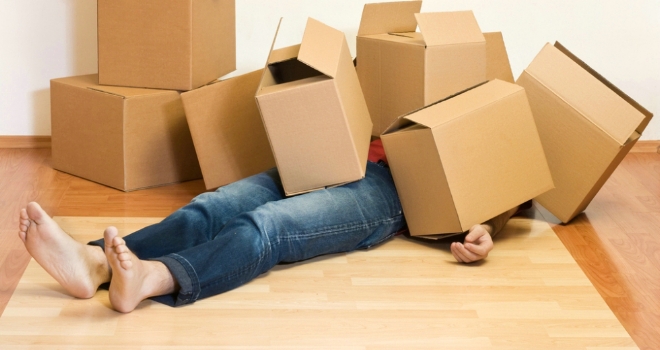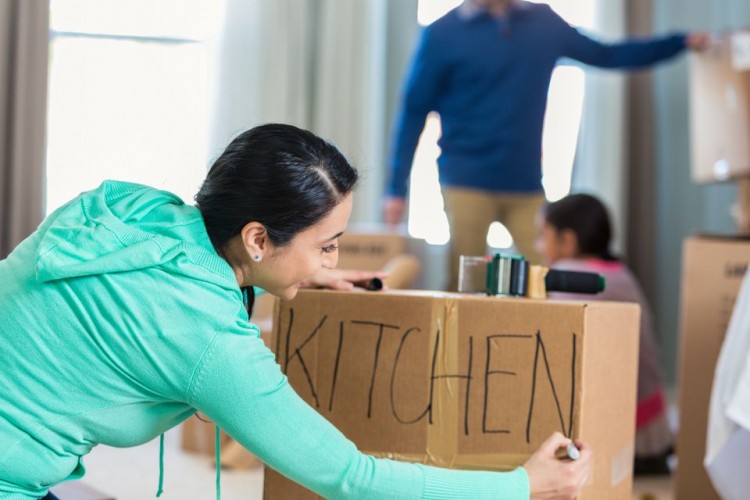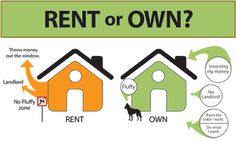
Moving house is a huge, life-changing event, but it doesn’t need to be a stressful one. Organization is key, and several simple steps can ease the process substantially and make moving more of a breeze. Careful, systematic preparation can eliminate much of the last-minute stress, mess, and confusion while preparing to move.
“The three-box rule applies to every room: Start with three empty boxes labeled "Keep," "Discard," and "Donate or Yard Sale." Replace each as needed during the process. “ – Big Tip from Home Moving Experts – Busy Chap
1. De-clutter! By clearing clutter and “small stuff” before major packing, it will be easier to see the big picture and provide more workspace. Pack up knickknacks, artwork, and decorative items first. Recycle outdated magazines, newspapers, and junk mail. Pack all items that are not essential to daily living and sort through junk drawers. Label carefully—don’t just write “Stuff” or “Miscellaneous” on a box; be specific about the contents, and write on sides and top. Put prepacked boxes in the garage or in one designated room.
2. Start from the top…or the bottom. Examine the attic or basement where some items may be already boxed for storage. Make sure they are labeled correctly, and check the condition of the boxes. Decide whether items are really worth keeping or if it is time to “let go” to a yard sale or charity. If time doesn’t permit a yard sale, many people do very well selling items online through eBay or craigslist; this may also help to offset some moving expenses.
3. Closets and drawers. It can be surprising how much accumulates in these small spaces! Pack up sports equipment, boots, shoes, jackets, raincoats, hats, gloves, umbrellas, toys, and games not being used at the time. Out-of-season clothing can be packed in empty luggage and gym bags. Wardrobe boxes are great, but clothing on hangers can also be laid flat upon an extra blanket or bedspread and then wrapped and knotted at the ends. This is quick and keeps them clean.
4. Books, VCR/DVD’s, music CD’s and albums. Smaller boxes for these items are best, especially heavy books. Many package or liquor stores offer free stacks daily and welcome takers, and their smaller size is perfect for these heavier items. Record albums should be packed on their sides instead of flat; the same rule applies to plates when packing dishes.
5. Vital records, documents, irreplaceable items. Do not put these in a moving truck! Personally move essential records and documents, such as birth certificates, identifications, insurance policies, vehicle titles, property deeds, passports, financial and tax records, treasury bonds and stock certificates, safety deposit box keys, medical and dental records, wills, irreplaceable heirlooms and photographs, valuable jewelry, personal phone directories, and any current bills.
6. Fragile items, glassware, china. Use sturdy boxes and clean packing paper; newsprint leaves smudges. Save newspaper for stuffing around already wrapped items. Linens, tablecloths, cloth napkins, and extra dishtowels can also be used for wrapping china and glassware. Put heavier items in the box first, and don’t over pack. Use bubble wrap for larger, precious pieces and box separately.
7. Electronics. Work with one component at a time and box separately, so parts won’t get mixed up. Unplug all connecting cords, cables, and wires. Bundle and tape attached cords to the unit itself; put any loose cables and remote controls in a labeled, zipper-type plastic bag and tape to the unit or store in the box. Be extra careful wrapping computer components; bubble wrap is wise, and keep software and manuals together in labeled plastic bags.
8. Bedrooms and Bathrooms. Clothing in drawers can often remain in place; remove the drawers, carry by hand to the truck, and slide them right back in place after moving the bureau or dresser frames. Plastic tote bins with lids are also a great investment; they stack well and keep clothing clean and protected. Leave just essential bedding in place. For bathrooms, pack all but daily toiletries and a few towels. Save a few fitted sheets out of the linen closet to protect mattresses and furniture from truck dirt.
9. Kitchen. Pack all but a few plates, mugs, cups, some cutlery, a couple of cooking pots, and a teakettle or coffee pot. Many kitchen items can be nested; fill empty cook pots with spices and small, unbreakable items. Again, label boxes specifically, according to bakeware, utensils, plates, mugs, small appliances, etc., so it will be easier to find what is needed first in a new kitchen. Toss out dated food products and old spices; only keep out food items that will be used up quickly. Clean each empty cabinet and drawer to save time later; leave them ajar to air out and as a reminder that they have already been emptied.

10. Outdoor furniture and tools. Clean all dirt, grease, yard debris, and cobwebs from outside items, as these will be mingled with household items in a truck. Empty all gasoline and oil from lawn equipment, and put what will fit in large garbage bags. An empty plastic trash bin works well for rakes, shovels, loppers, brooms, edgers, pruners, and other outdoor tools and equipment. Keep one small toolkit aside for reassembling any furniture or electronic equipment that was disassembled.
These steps will help with organisation before the big moving day. On moving day, in addition to the vital records box set aside, keep out one clearly marked, open box for last kitchen items, cell phones and chargers, tool kit, latest mail delivery, toilet paper, paper towel, any pet food and dishes, light bulbs, flashlight, and snacks. Remember to keep plenty of water containers in the refrigerator to stay hydrated during the physically demanding parts of the move. Having carefully organized the packing process, the stress has been alleviated and relaxation can begin!
Are you looking to buy property in UK ? Hurghada , Scotland , Istanbul , Sahl Hasheesh , Dubai
Are you looking to rent property in UK ? London , Manchester , Reading , Leeds , Cardiff











Author
James Helliwell